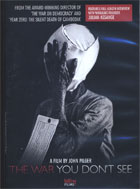
The War You Don’t See 2010
Distributed by Bullfrog Films, PO Box 149, Oley, PA 19547; 800-543-FROG (3764)
Produced by John Pilger, Alan Lowery
Directed by John Pilger, Alan Lowery
DVD, color, 96 min
College - General Adult
Journalism, Media Studies, International Relations
Date Entered: 01/12/2012
Reviewed by Brian Falato, University of South Florida Tampa Campus LibraryThe War You Don’t See features Bruce Springsteen singing “57 Channels (And Nothin’s On)” over the closing credits. This is an amusing way of reinforcing the documentary’s thesis that, despite the many channels for reporting available, there’s usually “nothing on” when it comes to investigative journalism that holds government accountable for its actions.
Written and presented by British journalist John Pilger, the documentary focuses primarily on the wars in Iraq and Afghanistan. Pilger contends that media in the United States and Britain were too accepting of the justifications for beginning the wars, and then failed to report stories of wholesale destruction of villages and mass killings of civilians during the wars.
One of the functions of the press in a democracy is to serve as a watchdog, so it’s important to explore the reasons why when it fails to do so. Pilger and those interviewed offer some explanations: a reluctance to criticize government officials and thus lose sources, the need to provide content to 24 hour news networks even when the official accounts of events haven’t been fully investigated, the control military and government officials have when reporters are embedded with combat units, and the fear that too much criticism could be seen as unpatriotic in a post-9/11 era.
But Pilger is more interested in showing us the scenes of civilian deaths and destruction of homes, exemplifying his title The War You Don’t See. Pilger would feel he’s doing a service to the public in presenting these scenes, but he doesn’t give us any background or context to the stories. He’s saying the media should dig deeper in stories and not accept the official account of events, but he’s not following his own advice. He doesn’t give us the details, just expects us to believe everything he presents is exactly as he says it is. It may well be, but we can’t make a reasonable decision without facts.
Pilger says there was a virtual media blackout on reporting these stories, but he doesn’t offer any content analysis of coverage to back this up, and doesn’t ask representatives of media organizations why these stories weren’t covered. He does ask them why they didn’t ask more questions leading to the buildup and why they spent so much time covering government pronouncements. The answer offered is that networks have a duty to cover the statements the government makes, but without endorsing them as undisputed facts. Pilger could have gotten into an in-depth discussion about the balance to be struck between reporting official news and investigation of what the government says, but if he did, it’s not included in this video.
He also includes a section on coverage of Israeli-Palestinian conflicts. He charges that the media reflects the Israeli point of view, because it’s scared of repercussions from the Israeli government if it does stories that could be viewed as favoring the Palestinian side. This is a serious charge, but if he was going to bring it up, he should have offered more evidence to bolster his point. As it is, it comes off more as Pilger having an ax to grind with Israel.
Pilger also throws in a truly bizarre bit of movie criticism. He lumps in Platoon and The Hurt Locker with The Green Berets as examples of Hollywood movies glorifying American behavior in war. There’s no doubt that The Green Berets fits this description, but to say that of Platoon or The Hurt Locker is an incredible misreading of the films. Here, Pilger is like government officials who see only what they want to see and reject anything not fitting their preconceived ideas.
This video cries out for some supplemental material about the incidents depicted, journalists’ attempts to get stories published or broadcast, or even about Pilger himself. But all we get in the way of extras is a 68-minute talking head interview with Wikileaks founder Julian Assange that is wholly admiring.
The War You Don’t See is still recommended despite its problems because it does raise important issues about the media’s role. But those viewing it should remember that just because a person rejects the “official story” doesn’t mean he is automatically correct in his contrary beliefs.